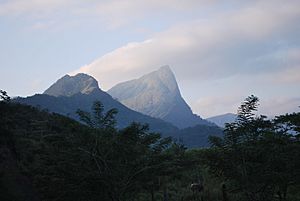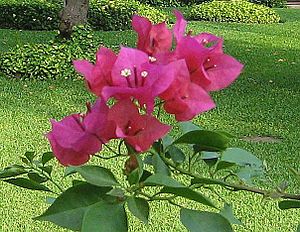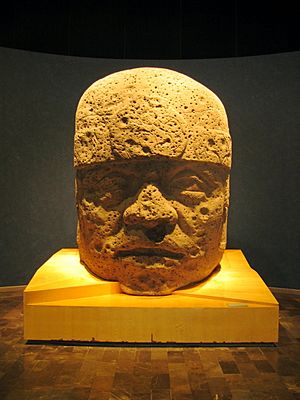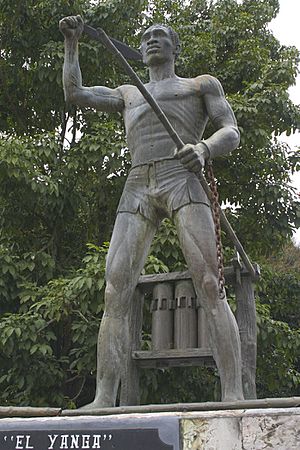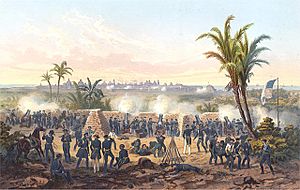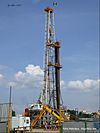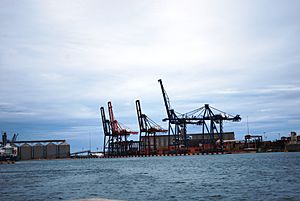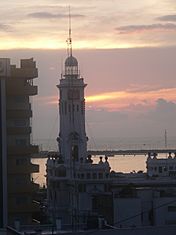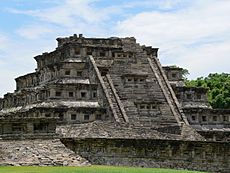Veracruz facts for kids
Quick facts for kids
Veracruz
|
||
|---|---|---|
| Free and Sovereign State of Veracruz de Ignacio de la Llave Estado Libre y Soberano de Veracruz de Ignacio de la Llave (Spanish) |
||
|
||
| Motto(s):
Plus Ultra
(Beyond)
|
||
| Anthem: Himno Veracruzano | ||
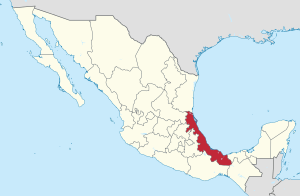
State of Veracruz within Mexico
|
||
| Country | Mexico | |
| Capital | Xalapa | |
| Largest city | Veracruz | |
| Largest metro area | Greater Veracruz | |
| Admission | December 22, 1823 | |
| Order | 7th | |
| Area | ||
| • Total | 71,826 km2 (27,732 sq mi) | |
| Ranked 11th | ||
| Highest elevation | 5,610 m (18,410 ft) | |
| Population
(2020)
|
||
| • Total | 8,062,579 | |
| • Rank | 4th | |
| • Density | 112.2515/km2 (290.7301/sq mi) | |
| • Density rank | 10th | |
| Demonym(s) |
|
|
| GDP | ||
| • Total | MXN 1.227 trillion (US$61.0 billion) (2022) |
|
| • Per capita | (US$7,491) (2022) | |
| Time zone | UTC−6 (CST) | |
| • Summer (DST) | UTC−5 (CDT) | |
| Postal code |
91-96
|
|
| Area code |
Area codes
|
|
| ISO 3166 code | MX-VER | |
| HDI | ||
Veracruz, officially known as the Free and Sovereign State of Veracruz de Ignacio de la Llave, is one of Mexico's 32 states. It's located in eastern Mexico, along the beautiful Gulf of Mexico. Veracruz shares borders with seven other states: Tamaulipas, San Luis Potosí, Hidalgo, Puebla, Oaxaca, Chiapas, and Tabasco.
The state is divided into 212 smaller areas called municipalities. Its capital city is Xalapa-Enríquez. Veracruz is famous for its diverse population, which includes many different ethnic and indigenous groups. The food in Veracruz is also special, showing off the many cultures that have passed through its important port city. Besides Xalapa, other big cities include Veracruz, Coatzacoalcos, Córdoba, and Orizaba.
Contents
- What's in a Name? The Story of Veracruz
- Exploring Veracruz: Land and Climate
- A Look Back: Veracruz's History
- Veracruz's Economy: What People Do
- Veracruz Culture: Food, Music, and Art
- Learning in Veracruz
- People of Veracruz
- Visiting Veracruz: Fun for Tourists
- Ancient Sites to Discover
- How Veracruz is Governed
- Images for kids
- Notable People
- See also
What's in a Name? The Story of Veracruz
The full name of the state is Veracruz de Ignacio de la Llave. The name "Veracruz" comes from the city of Veracruz. Its original name was Villa Rica de la Vera Cruz, which means "Rich Town of the True Cross" in Latin.
The second part of the name, "de Ignacio de la Llave," honors Ignacio de la Llave y Segura Zevallos. He was the governor of Veracruz from 1861 to 1862. The state's official seal was approved in 1954. It uses a design from the 16th century that was first used for the port of Veracruz by the Spanish.
A Story of Freedom: Yanga and the Maroons
Long ago, enslaved Africans were brought to Veracruz by Spanish colonists. Many of them bravely escaped from plantations and found safety in the mountains, living with the local Indigenous people. These communities of escaped enslaved people were called maroons.
One famous leader was Gaspar Yanga, who came from Gabon. He led a revolt in the late 1500s. Yanga and his followers would raid the main road between Veracruz and Mexico City. In 1609, the Spanish government sent soldiers to stop them. After some fighting and talks, a peace agreement was made.
This agreement allowed the escaped Africans to form their own free town. This town was first called San Lorenzo de Zerral. Later, in 1956, it was officially renamed Yanga. This was a very important moment, as it was one of the first places in the Americas where slavery was ended. Today, many people in Veracruz have a mix of African, Indigenous, and Spanish heritage, which is celebrated in their culture, music, and food.
Exploring Veracruz: Land and Climate
Veracruz is a long, crescent-shaped state. It's squeezed between the Sierra Madre Oriental mountains to the west and the Gulf of Mexico to the east. The state is about 650 km (403.9 mi) long from north to south. Its width changes, but it's about 100 km (62 mi) wide on average. Veracruz has a long coastline of 690 km (429 mi) along the Gulf of Mexico.
Mountains, Rivers, and Coastlines


Veracruz has many different landscapes. It goes from flat coastal areas to the high peaks of the Sierra Madre mountains. The lowest point is sea level, and the highest is Pico de Orizaba. This is Mexico's tallest mountain, standing at 5,636 m (18,491 ft) above sea level. Pico de Orizaba is covered in snow all year round.
More than 40 rivers and smaller streams flow through Veracruz. They all start in the mountains and flow east into the Gulf of Mexico. These rivers are important for farming and making electricity. Some of the biggest rivers are the Pánuco, Tuxpan, and Papaloapan.
The state also has ten major waterfalls and ten large coastal lagoons. The only important lake is Lake Catemaco. Off the coast, there are several islands and coral reefs, like the Veracruz Reef System National Park.
Veracruz's Diverse Climates
| Weather chart for Veracruz | |||||||||||||||||||||||||||||||||||||||||||||||
|---|---|---|---|---|---|---|---|---|---|---|---|---|---|---|---|---|---|---|---|---|---|---|---|---|---|---|---|---|---|---|---|---|---|---|---|---|---|---|---|---|---|---|---|---|---|---|---|
| J | F | M | A | M | J | J | A | S | O | N | D | ||||||||||||||||||||||||||||||||||||
|
50
24
14
|
32
28
16
|
18
28
16
|
48
31
19
|
73
33
21
|
308
29
20
|
250
29
19
|
125
31
21
|
387
28
20
|
204
27
18
|
54
25
14
|
36
25
14
|
||||||||||||||||||||||||||||||||||||
| temperatures in °C precipitation totals in mm source: Comisión Nacional del Agua |
|||||||||||||||||||||||||||||||||||||||||||||||
|
Imperial conversion
|
|||||||||||||||||||||||||||||||||||||||||||||||
Veracruz has many different climates because of its varied altitudes. You can find cold, snowy mountain peaks and hot, humid tropical areas along the coast.
- Hot and Humid: About 32% of the state is hot and humid, and 52% is hot and semi-humid. These climates are found from sea level up to about 1,000 m (3,280.8 ft). Temperatures usually range from 22 to 26°C.
- Cooler and Humid: These climates are found at elevations between 1,000 m (3,280.8 ft) and 1,600 m (5,249.3 ft). The average temperature is between 18 and 22°C.
- Temperate: Higher up, between 1,600 m (5,249.3 ft) and 2,800 m (9,186.4 ft), temperatures are cooler, from 12 to 18°C.
- Cold: The highest parts of the state, like Pico de Orizaba, have cold climates with snow.
There's also a small dry area around the city of Perote. This happens because the mountains block moist air from the Gulf.
Amazing Plants and Animals

Veracruz is home to many different types of forests, especially evergreen tropical forests. This area is very important for many plant and animal species. It has many plants and birds that are found nowhere else in the world.
The state has an incredible variety of wildlife. You can find unique insects, like the Arsenura armida moth, and over 25 kinds of tarantulas. Many birds found here are unique to the region, such as the green-cheeked amazon parrot.
Veracruz is also a key stop for birds that migrate (travel) long distances. Many endangered animals live here, including two types of rodents, the jaguar, ocelot, and Baird's tapir. The mantled howler monkey also lives in the southern jungle regions.
Sadly, much of Veracruz's original forests have been cut down for farming and other human activities. Only about 20% of the original ecosystem remains. However, there are 31 protected areas in the state, including national parks like Pico de Orizaba and Cofre de Perote. The Los Tuxtlas Biosphere Reserve is a large protected area with many different climates and thousands of plant and animal species.
A Look Back: Veracruz's History
Ancient Civilizations of Veracruz
Before the Spanish arrived, the land of Veracruz was home to several important Indigenous cultures.
- Olmecs: The Olmecs were one of the oldest civilizations in the Americas. They lived in the southern part of Veracruz, especially around the Coatzacoalcos River. Their main center was San Lorenzo Tenochtitlán. They are famous for their huge stone heads. Many experts believe the Olmecs were the "mother culture" for later Mesoamerican civilizations.
- Totonacs: The Totonac people lived in the central-northern part of the state, in a region called Totonacapan. They were farmers, hunters, and fishers. They are known for their clay sculptures with smiling faces. The ancient city of El Tajín was a major Totonac site.
- Huastecs: The Huastecs lived in the far north of Veracruz. Their language and farming methods were similar to the Maya people.
- Aztecs: In the 1400s and early 1500s, the Aztecs took control of much of Veracruz. They wanted the area's valuable crops like cotton, cacao, and vanilla. However, the Totonacs often rebelled against Aztec rule.
The Spanish Arrival and Colonial Times
Veracruz played a huge role in the Spanish conquest of the Aztec Empire. On May 18, 1519, Hernán Cortés and his group founded the first Spanish town in Mexico, called Villa Rica de la Vera Cruz.
The Totonacs were among the first Indigenous groups the Spanish met. They were unhappy with Aztec rule, so their leader welcomed Cortés. The Totonacs helped the Spanish fight against the Aztecs.
During the time of Spanish rule (the colonial era), Veracruz became the most important port for trade between Mexico and Spain. Goods like silver, dyes, chocolate, and vanilla were sent to Spain. In return, livestock, wheat, and other crops came to Mexico. This made the port a target for pirates, so the Spanish built the San Juan de Ulúa fort to protect it.
Sadly, European diseases brought by the Spanish greatly reduced the Indigenous population. This led to the Spanish bringing enslaved Africans to Mexico starting in the 16th century. Many of these enslaved people escaped and formed their own communities, sometimes joining with Indigenous groups. One such rebellion, led by Gaspar Yanga, resulted in the creation of the first free African community in the Americas, called Yanga.
Becoming an Independent State
During the Mexican War of Independence (1810-1821), many people in Veracruz supported the fight for freedom from Spain. In 1821, Mexico became independent. However, Spanish troops held onto the San Juan de Ulúa fort until 1823. The city of Veracruz earned the title of "heroic city" for fighting these remaining Spanish forces.
After independence, Mexico faced many challenges. Veracruz was involved in several conflicts.
- Pastry War (1838): The French attacked Veracruz to demand payment for debts.
- Mexican-American War (1846-1848): American forces blockaded and captured the port of Veracruz. They then marched inland towards Mexico City.
- Reform War (1858-1861): During this civil war, the liberal government of Benito Juárez used Veracruz as its base.
- French Intervention (1861-1867): French forces invaded Mexico through Veracruz and tried to set up an empire under Maximilian I. But they were eventually driven out.
In 1863, the state was officially named Veracruz-Llave. Over time, roads and railways were built, and oil was discovered in the north, bringing new industries to the state.
Veracruz in the 20th Century
The early 1900s saw workers' strikes in Veracruz, especially among cigar makers. These events contributed to the start of the Mexican Revolution (1910-1920), which overthrew the government of Porfirio Díaz.
In 1914, American troops landed in Veracruz for six months due to a conflict. After the Revolution, land was given to farmers, and oil companies were nationalized, meaning they became owned by the Mexican government. The Universidad Veracruzana was expanded, and new roads and airports were built, helping the state grow.
Veracruz's Economy: What People Do
Veracruz has one of Mexico's strongest economies. It's mainly based on farming and oil.
Farming and Fishing
Farming has been important in Veracruz for thousands of years. The state has fertile soil, plenty of rain, and a long coastline.
- Crops: Veracruz is a top producer of coffee, sugarcane, corn, rice, and citrus fruits (like oranges and limes). It's also the biggest mango producer in Mexico. Vanilla beans are native to Veracruz, and most of Mexico's vanilla comes from the Papantla area.
- Livestock: Raising animals is also a big part of the economy. Veracruz is the main producer of beef in Mexico. Farmers also raise dairy cattle, pigs, sheep, goats, and chickens.
- Forestry: About 20% of the state is covered in forests. People harvest wood from pine, oak, and tropical hardwood trees.
- Fishing: With its long coastline, Veracruz has a large fishing industry. It produces a fifth of Mexico's total fish catch. Popular catches include mojarra, oysters, shrimp, crab, and red snapper.
Oil and Industry
Veracruz is rich in natural resources. About 35% of Mexico's water supply is found here. While there's some mining for metals like iron and copper, oil is the most important resource.
Veracruz has about a quarter of Mexico's oil reserves and is the third-largest oil producer. Most of the oil comes from the northern part of the state. The state also has 22 petrochemical plants, which process oil into other products.
The Laguna Verde Nuclear Power Plant in Alto Lucero produces about 4.5% of Mexico's electricity.
Trade and Transportation
Transportation and trade are very important in Veracruz, especially for importing and exporting goods. The port of Veracruz is the busiest port on Mexico's Gulf coast. It handles 75% of all port activity in Mexico. Goods are exported to the United States, Latin America, and Europe.
Other important ports are in Tuxpan and Coatzacoalcos. The state has a good network of highways and railways, mostly connecting to these ports. There are also three major airports, including the international airport in Veracruz city.
Handicrafts: Art from the Heart
In the rural and Indigenous areas of Veracruz, people still make beautiful handicrafts.
- Woodwork: The Huasteca people make furniture and other items from cedar and palm wood. Musical instruments like the "jarana" guitar are made in the Los Tuxtlas area.
- Ceramics: Pottery has been made in Veracruz since the Olmec times. Papantla is known for its clay figures with smiling faces.
- Textiles: Traditional clothing and embroidery are found in the La Huasteca area. People make elaborately decorated blouses and wool items like dresses and jackets.
- Other Crafts: Palm fronds are woven into fans and baskets. Leather items like shoes and belts are also popular.
Veracruz Culture: Food, Music, and Art
Delicious Veracruz Food
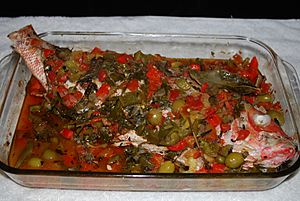
The food in Veracruz is unique in Mexico. It's a mix of Spanish, Indigenous, and other influences.
- Native Flavors: Before the Spanish arrived, people ate corn, beans, squash, tropical fruits, vanilla, and an herb called hoja santa. Seafood was also very important.
- New Ingredients: The Spanish brought new spices like saffron, parsley, and cinnamon. They also brought wheat, rice, almonds, olives, and garlic. These ingredients are key in famous dishes like huachinango a la veracruzana, which is red snapper in a spicy tomato sauce.
- Regional Dishes: Veracruz cuisine has different styles depending on the region.
- Sotavento (South): Dishes here often use rice and seafood, like arroz a la tumbada (rice with seafood or meat).
- Centro Norte (Central North): This area, around Xalapa, has more Indigenous-style dishes with mild chili peppers.
- Los Tuxtlas: This region features yucca, fish (especially mojarra), and sometimes exotic meats.
Museums and History
Veracruz has many interesting museums.
- Museum of Anthropology (Xalapa): This museum has the second most important collection of ancient Mesoamerican artifacts in Mexico. It focuses on the Olmec and Totonac cultures. You can see a huge Olmec stone head called El Rey (The King) here.
- Hacienda del Lencero (near Xalapa): This was the home of President Antonio López de Santa Anna in the 19th century. It's now a museum.
- Regional Museum of Anthropology (Tuxpan): This museum displays over 400 pieces from ancient groups in the region.
- Veracruz State Art Museum (Orizaba): Located in a former monastery, this museum has works by famous artists like Diego Rivera.
Festivals and Celebrations
Veracruz is known for its many colorful festivals.
- Carnival (Veracruz City): This is the most important festival. It starts with burning an effigy (a dummy) of "bad humor." Kings and queens are crowned, including for children. Parades fill the streets with music and dancing.
- Day of the Dead: Celebrated from October 31 to November 2, it has local traditions. In Papantla, people decorate rooftops with flowers and plants.
- Candlemas: This Christian celebration is mixed with traditions honoring Chalchiuhtlicua, the goddess of water. It's very important in coastal towns like Tlacotalpan, where fishermen celebrate their protector.
Music and Dance: The Soul of Veracruz
The state is famous for its music and dance.
- Fandango: This dance came from Spain and has two main styles in Veracruz: jarocho and huasteco.
- Traditional Dances: Many Indigenous dances are part of rituals and religious festivals. Examples include Los Lisceres (Tigers), Los Guaguas (honoring the sun), and Los Negritos (Little Black Ones), which was created by African enslaved people.
- Danza de los Voladores (Dance of the Flyers): This amazing ritual is best known in Papantla. Five participants climb a 30-meter pole. Four of them then launch themselves, tied by ropes, and spin down to the ground. The fifth stays on top, playing a flute and drum. This ritual was created to ask the gods for rain during a drought. UNESCO has recognized it as an Intangible Cultural Heritage to help keep it alive.
- Son Music: The most popular music style in Veracruz is called "son." It mixes Indigenous, Spanish, African, and other influences. It's usually played with harps, violins, and guitars. Son jarocho, played in the south, is the most famous style. The Grammy-winning song "La Bamba" by Los Lobos comes from a traditional son jarocho folk song from Veracruz.
Art and Architecture
Veracruz has a rich history of art.
- Colonial Art: During the Spanish colonial era, a "Veracruz style" of painting developed. It focused on the state's landscapes, like mountains and volcanoes, often with Indigenous influences.
- Famous Artists: Important artists from the 19th and 20th centuries include Salvador Ferrando, known for portraits and landscapes, and José María Jara, who painted Veracruz customs. Teodoro Cano García is a famous muralist from the 20th century, known for promoting Totonac culture.
- Architecture: Most of Veracruz's older buildings are in inland cities like Xalapa and Córdoba. The architecture shows Spanish colonial, Moorish, and Neoclassical styles.
Literature: Stories and Poems
Veracruz has produced many important writers.
- Salvador Díaz Mirón: A distinguished poet from the late 19th and early 20th centuries. He wrote some of Mexico's first Romantic poems.
- María Enriqueta Camarillo: A prominent woman writer known for Rosas de la infancia, a book many Mexicans learned to read with.
- 20th Century Writers: Later writers, like Gregorio López y Fuentes and Manuel Maples Arce, often wrote about social issues. Emilio Carballido was a very prolific playwright and scriptwriter, known for about 100 plays.
Learning in Veracruz
Education in Veracruz is managed by the state government. There are over 20,000 schools, with nearly 2 million students and about 85,000 teachers. Most schools are for basic education (preschool, primary, and middle school). There are also schools for special education and technical institutes.
A big focus is on bilingual education for Indigenous populations, teaching in both their native language and Spanish. This helps reduce illiteracy in these communities.
The main state university is the Universidad Veracruzana, located in Xalapa. It offers many different degrees and has campuses in 14 other cities. Other important schools include the Instituto Tecnologico de Veracruz and the Veracruz Naval Academy.
People of Veracruz
| Historical population | ||
|---|---|---|
| Year | Pop. | ±% |
| 1895 | 863,220 | — |
| 1900 | 981,030 | +13.6% |
| 1910 | 1,132,859 | +15.5% |
| 1921 | 1,159,935 | +2.4% |
| 1930 | 1,377,293 | +18.7% |
| 1940 | 1,619,338 | +17.6% |
| 1950 | 2,040,231 | +26.0% |
| 1960 | 2,727,899 | +33.7% |
| 1970 | 3,815,422 | +39.9% |
| 1980 | 5,387,680 | +41.2% |
| 1990 | 6,228,239 | +15.6% |
| 1995 | 6,737,324 | +8.2% |
| 2000 | 6,908,975 | +2.5% |
| 2005 | 7,110,214 | +2.9% |
| 2010 | 7,643,194 | +7.5% |
| 2015 | 8,112,505 | +6.1% |
| 2020 | 8,062,579 | −0.6% |
Veracruz has always been a place where different cultures meet. The port of Veracruz brought people from Europe, Africa, and the Caribbean. This mix of cultures can be seen in the state's music, food, and its people.
The state has over 2,000 Indigenous communities. The largest groups are the Nahuas, Totonacs, and Huastecs. Most Indigenous communities live in 68 specific municipalities. In 2005, over 600,000 people spoke an Indigenous language.
Small groups of immigrants from Spain, Italy, and Lebanon also live here. Africans were first brought to Veracruz as enslaved people. Many escaped and formed their own communities, sometimes mixing with Indigenous groups. Today, most people of African descent in Veracruz are mixed with the rest of the population.
With a population of over 8 million people (2020), Veracruz is the fourth most populated state in Mexico. Most people in Veracruz are Catholic, but there are also Protestants and people of Jewish faith.
Visiting Veracruz: Fun for Tourists
Tourism in Veracruz mostly centers around the port city of Veracruz. However, there are many other great places to visit. The state has over 1,000 hotels, with many larger ones in the Veracruz metropolitan area.
Explore the Port City of Veracruz
The port city of Veracruz has many historical and cultural sites.
- Aquarium: A popular attraction with marine life.
- Museum of the City: Learn about the city's history.
- Agustín Lara Museum: Dedicated to the famous musician.
- Santiago Fortress: An old fort that protected the city.
- San Juan de Ulúa Fort: A historic fort where Cortés landed.
Northern Veracruz: Culture and Nature
To the north of the port city is the Totonacapan area, home to the Totonac people.
- El Tajín: This is an important ancient city built by the Totonacs. It's a UNESCO World Heritage site.
- Papantla: This modern city is famous for the Totonac version of the “danza de voladores” (Dance of the Flyers). Dancers spin from tall poles. This area is also where the vanilla bean comes from.
Southern Veracruz: Tropical Adventures
To the south of the port, you'll find Catemaco, a tropical area.
- Lake Catemaco: A beautiful lake located in the crater of an extinct volcano.
- Isla Tanaxpillo: Also known as the island of the monkeys, due to a group of wild monkeys living there.
Inland Veracruz: Coffee and Mountains
Inland, you can explore the coffee-growing region around Coatepec and Xalapa. Orizaba is known for the nearby volcano and a large waterfall called El Elefante.
Ancient Sites to Discover
Veracruz has many amazing ancient sites from the Olmec, Totonac, and Huastec civilizations.
- El Tajín: A ruined city that was very important between the 9th and 13th centuries AD. It was named a UNESCO World Heritage site in 1992. Its most famous building is the Pyramid of the Niches, which has 365 niches.
- El Zapotal: Discovered in 1971, this site is known for its clay figures with smiling faces.
- Cempoala: Located on the coast, this city was inhabited when Hernán Cortés arrived. He formed an alliance with the Totonacs here against the Aztecs.
- Quiahuiztlán: This site is built into a mountain and is near where Cortés first settled.
- Castillo de Teayo: This is actually a pyramid located on the border between Huastec and Totonac lands.
- Tres Zapotes: This site is known for its large stone sculptures, including Stele "C."
How Veracruz is Governed
Veracruz became a state in 1824. It is led by a governor, who is elected for one six-year term. The state also has a legislature called the State Congress, whose members are elected for three-year terms.
The state is divided into 212 local government units called municipalities. Each municipality has a main city or town. These municipalities are grouped into regions like Huasteca Alta, Totonac, and De las Montañas.
Images for kids
Notable People
- Lorena Alarcon-Casas Wright, a physician and Associate Professor at the University of Washington School of Medicine.
See also
 In Spanish: Veracruz de Ignacio de la Llave para niños
In Spanish: Veracruz de Ignacio de la Llave para niños



